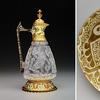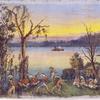Speaking through Painting - A Work by Anatoly Belkin
- August 03, 2011 18:42
I always seem to be getting myself into situations that need an incredible amount of translation. Whether it's hopping on a plane to shop for antiques in Brazil (no, I didn't speak much Portuguese) or buying unsigned paintings (something I've gotten quite good at, if one can be 'good' at such things) or buying paintings from other parts of the world where English really isn't the norm. And that's where I am now. Translating a Russian painting. Wait a minute, did I say translating a painting? Yes. This particular work by contemporary Russian artist Anatoly Belkin is full of symbolism and words. In Cyrillic.
Looking at the painting one late morning at the New York City flea market (I couldn't go at my usual early hour), I knew that it was something special. I spoke with my friend about the painting and as antique dealers are apt to do, he tried to talk me out of buying it. "Heather, everyone has seen this already", he said. I bought it anyway. The business is a funny one and if a dealer thinks that all the 'right' people have already seen something and passed on it they sometimes lose a little faith in it. It only makes sense because we as dealers are buying on our own taste. If those choices are not validated by a sale, we begin to think that we made a mistake. It's just how the business works. But, back to the painting...
I asked my friend what it was all about and who the artist was. His only information was that it was a painting of a samovar and was full of Russian words. There are plenty of dealers at the flea market who speak Russian, but I chose to try my hand at translation. First though, I had to figure out who actually painted the painting. Signed with a monogram and dated 91, I couldn't wait to get home and begin my search. Trying a few different online sites, I finally found the one that gave me my answer (for just $25 per year). The monogram Ab is for Anatoly Belkin. Turns out he's alive and well and painting in Russia. He was born in 1953, went to art school in Russia and works in St. Petersburg. Great. Now, what does the painting say? Looks like another search is in order...
Found another great site, this one to translate the Cyrillic alphabet. Working the letters out and then searching again gave me my answers. Sort of. The painting says a lot about tea. And Soviet poets. And truth. Or actually un-truth. So, here goes. At the very top is the name of a famous Soviet poet Vladimir Mayakovsky. Mr. Mayakovsky was born in 1893 and lived a life that he cut short, committing suicide in 1930. Those years in between were filled with protests, jail terms, love affairs, poems, stage plays, friendships and so much more. He was close friends with David Burliuk and the two would explore Futurism in it's many veins. They were known to stand on street corners reciting poetry and throwing tea at their audiences. This was to annoy the bourgeois art establishment. From what I read, they were quite successful. In another refernce to tea, Mr. Mayakovsky is know to have said about Anton Chekhov, "Language is as precise as 'hello' and as simple as 'give me a glass of tea". There is also a famous poem by Mayakovsky where he commands the sun to stay with him and have a tea.
And what is all this talk about tea? Well, the samovar is the main focus of the painting. At the top left, there is the simple statement, "This is tea". And below that one reads the word for 'very good". It was all starting to come together. Sort of. And now for the truth, or rather un-truth. The newspaper Pravda features quite prominently along with the slogan, Workers of the World Unite! But what are the letters before and after Pravda? Well, the addition of those letters turn Pravda (truth) into un-truth or falsity.
So what does this all mean? Not sure yet. Literal translations of art are pretty superficial. The truer deeper meaning is in the understanding. And for that understanding, I'll be spending some more time with the painting and my computer. Searching for the answers and the understanding.






100x100_n.jpg)
100x100_c.jpg)













